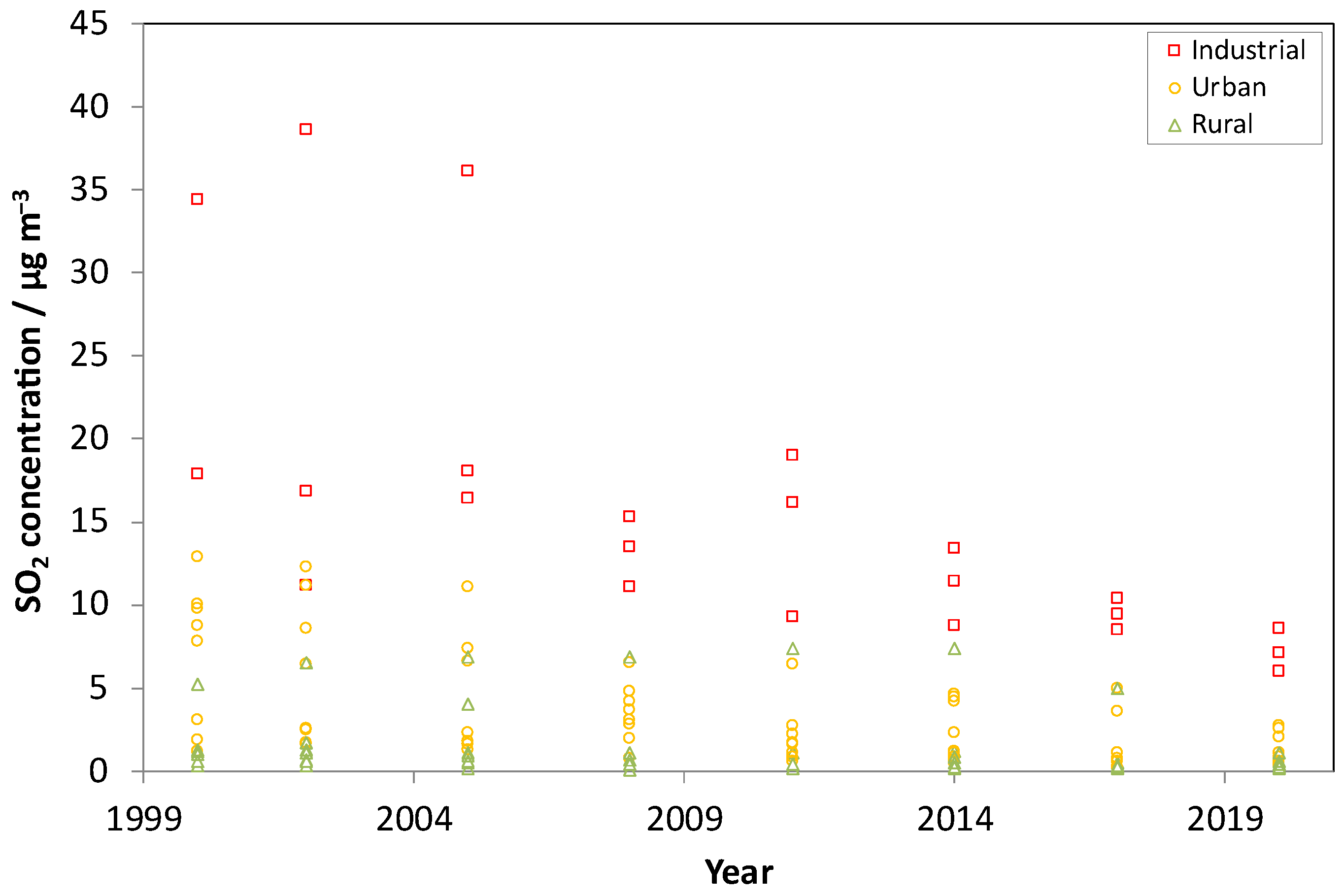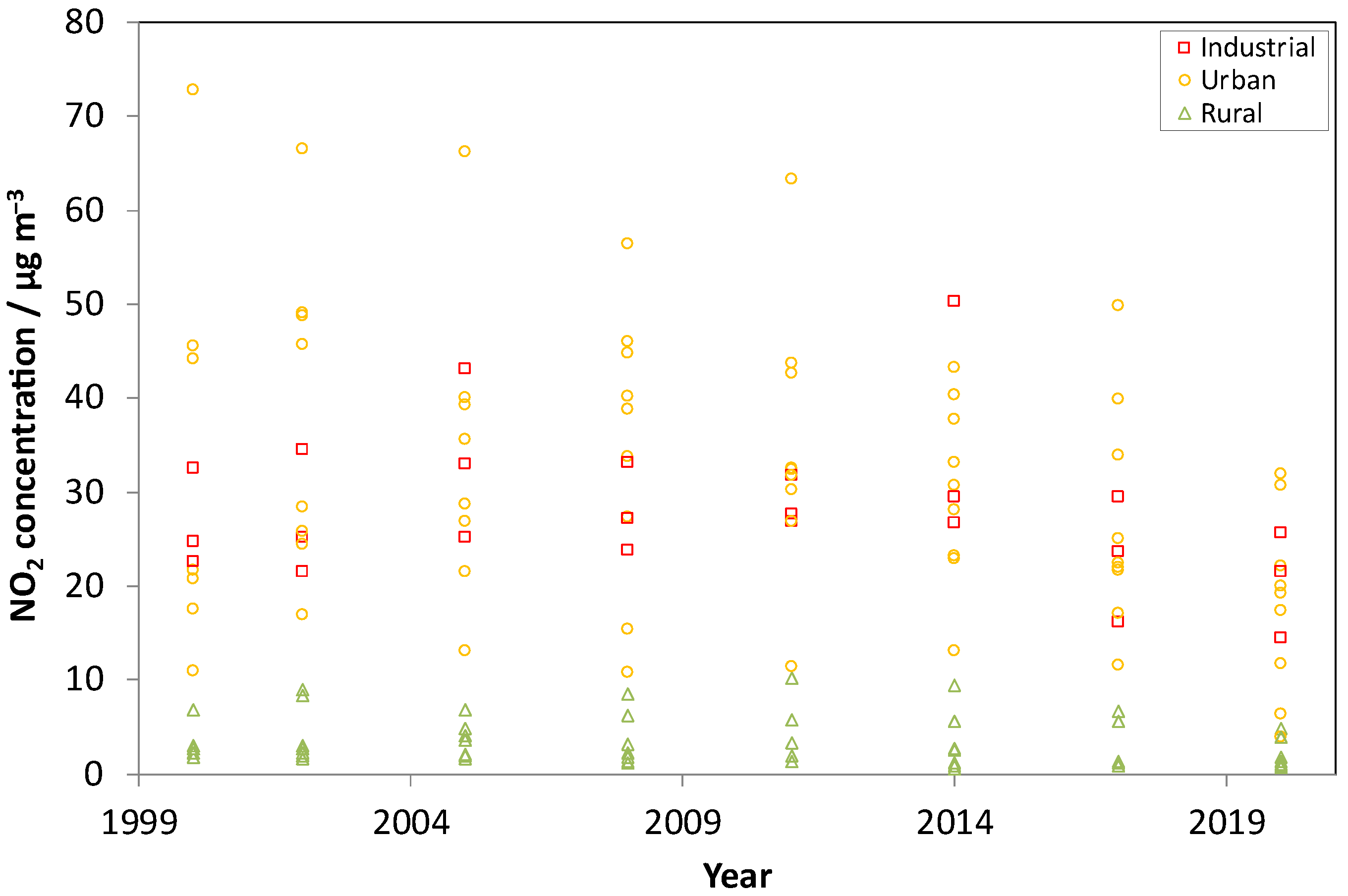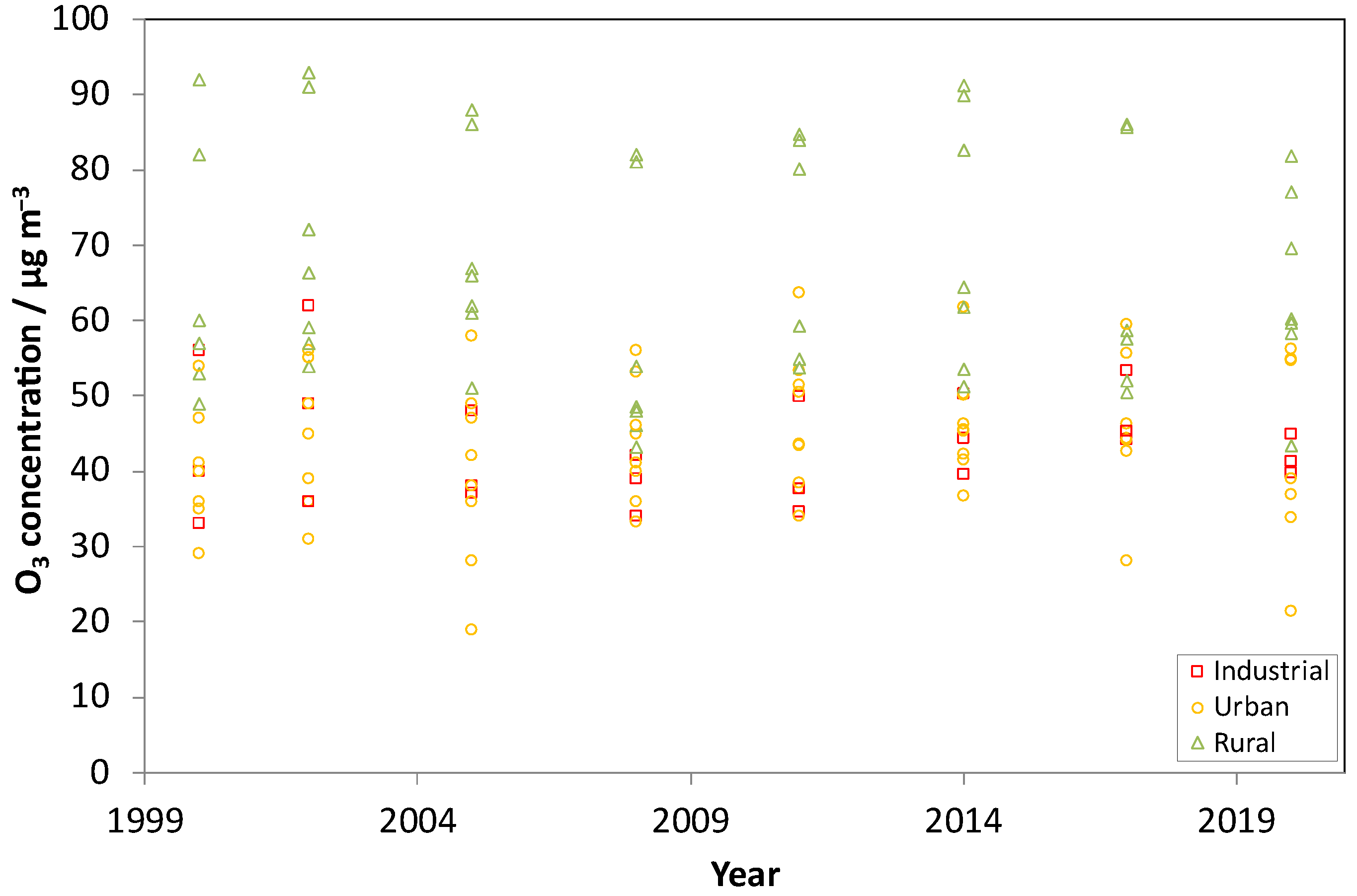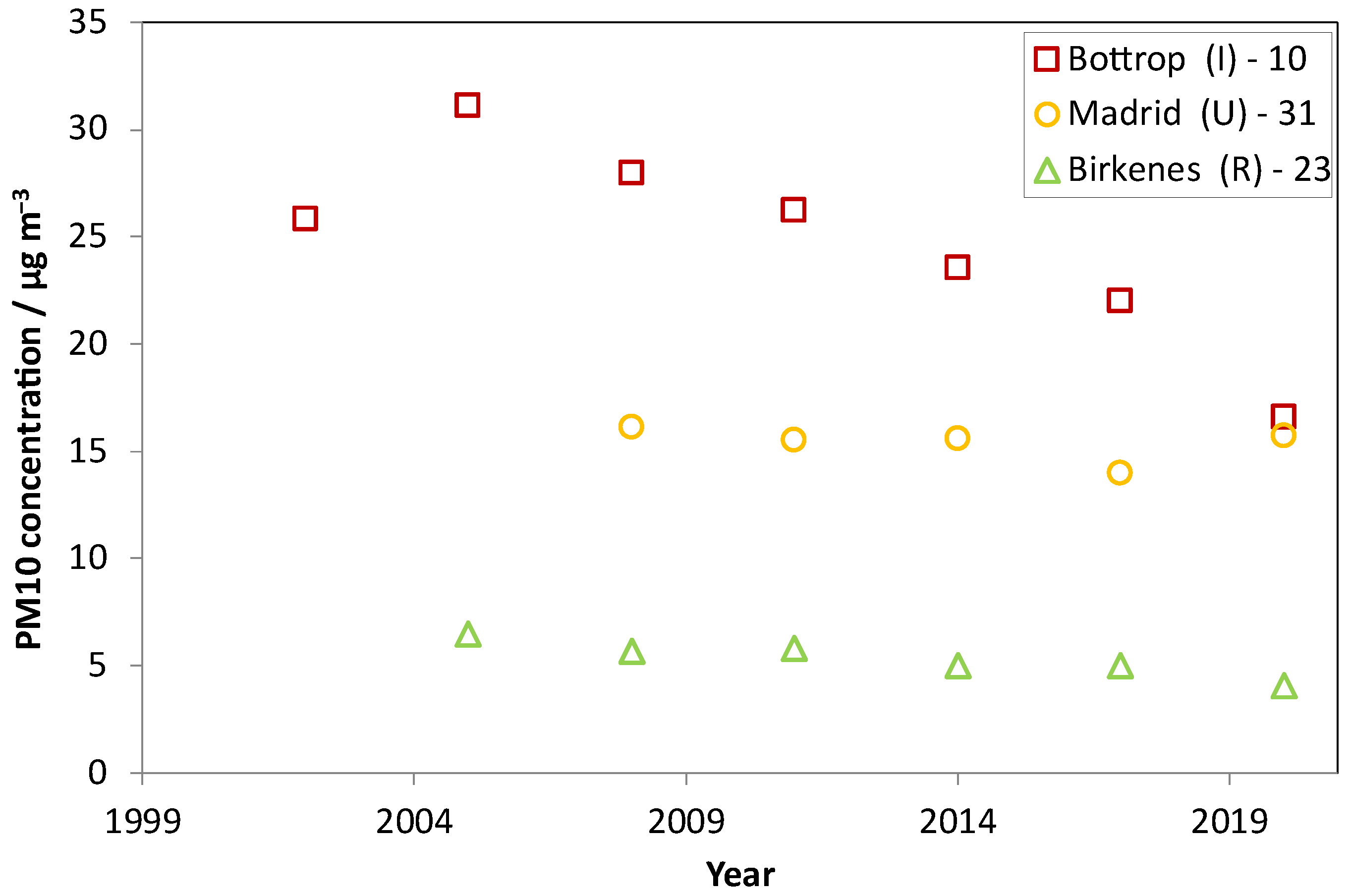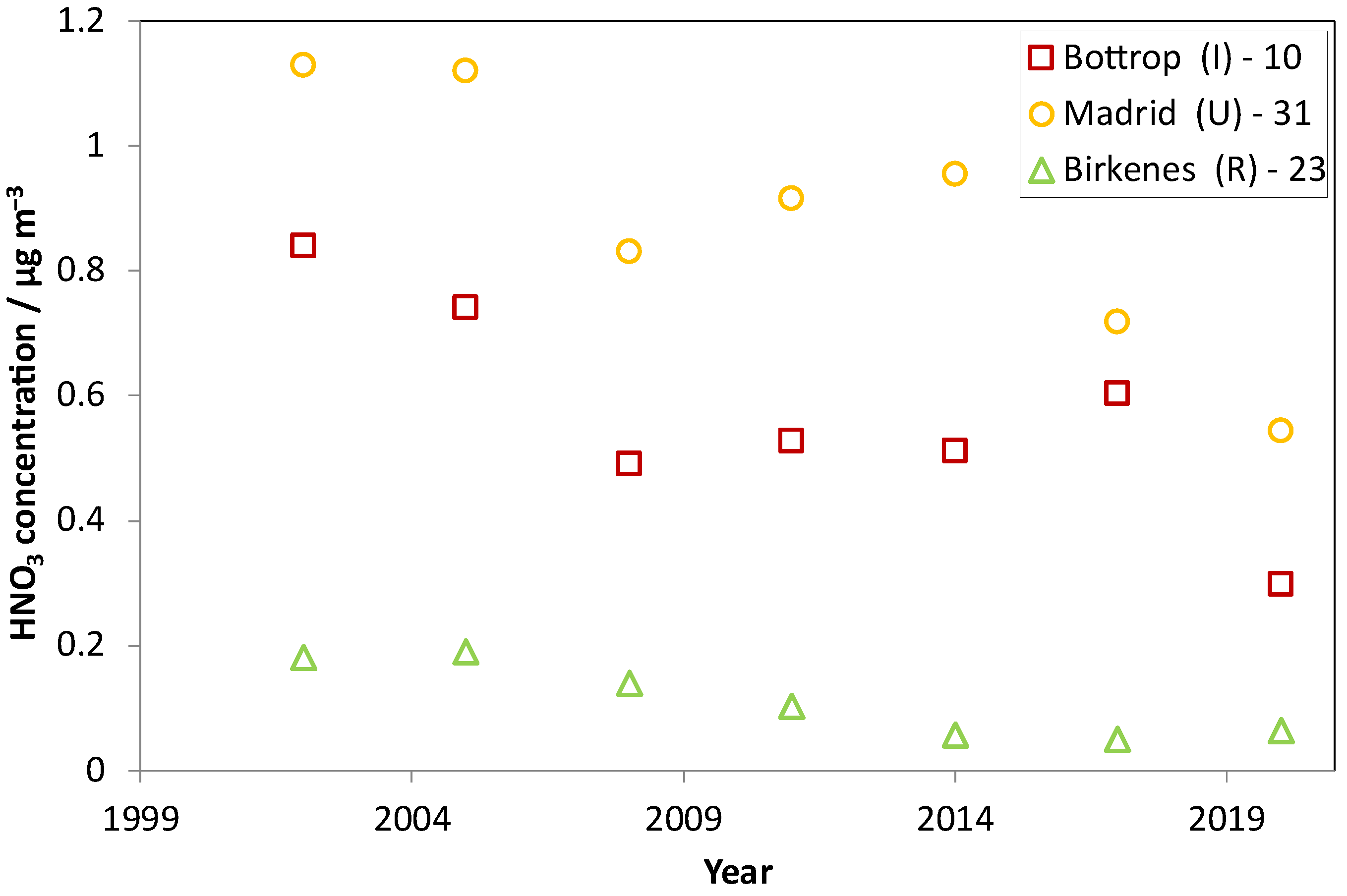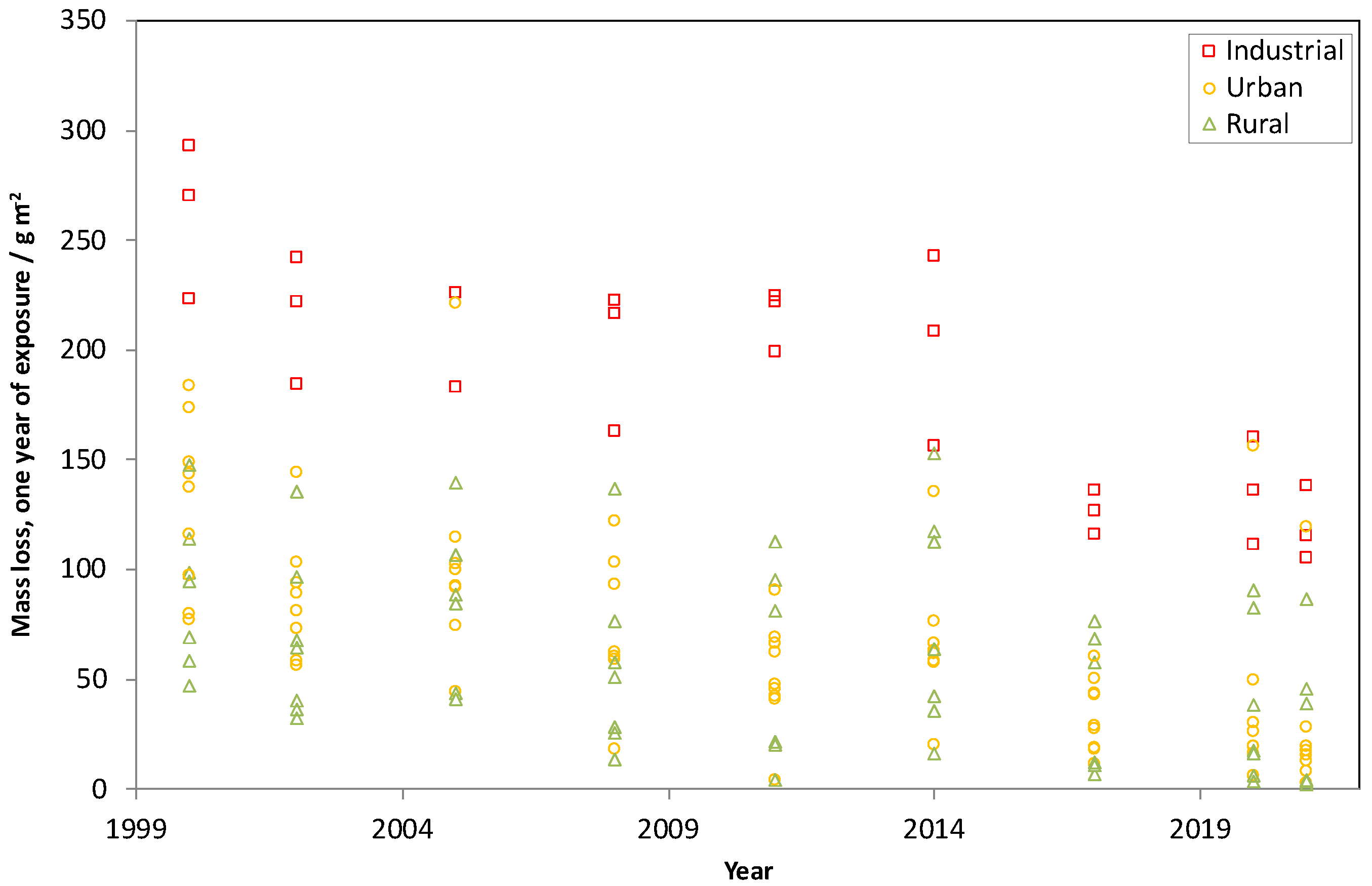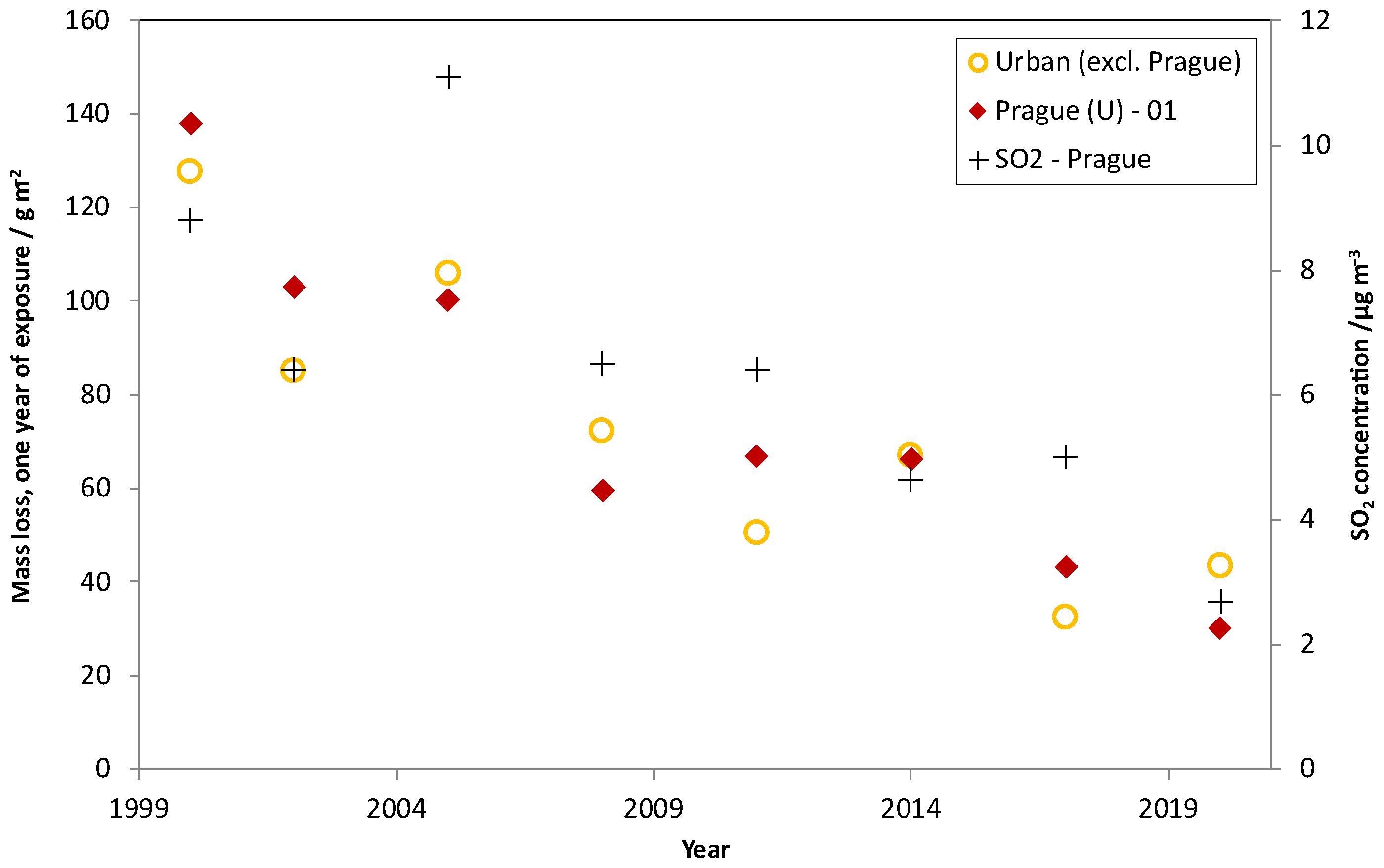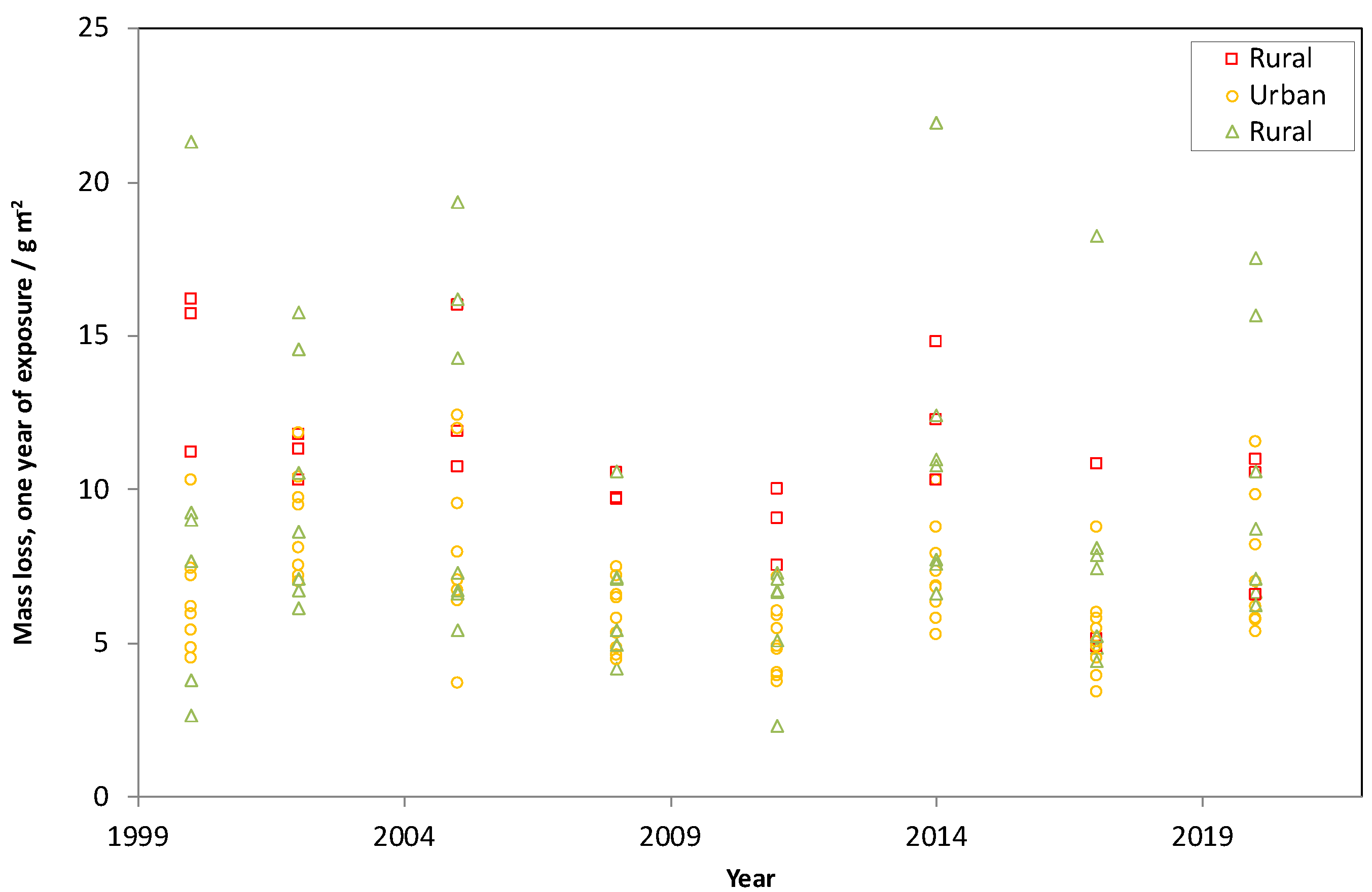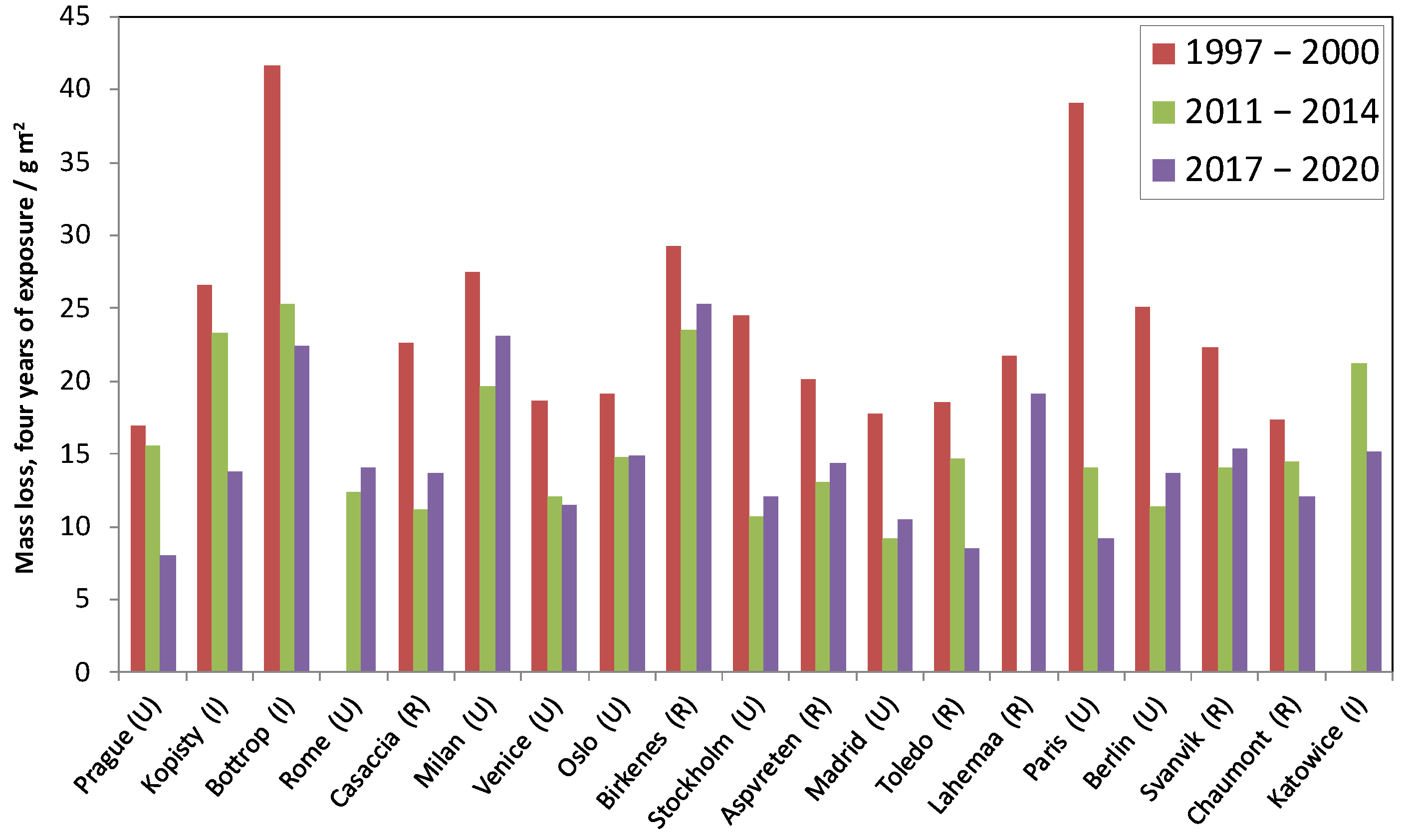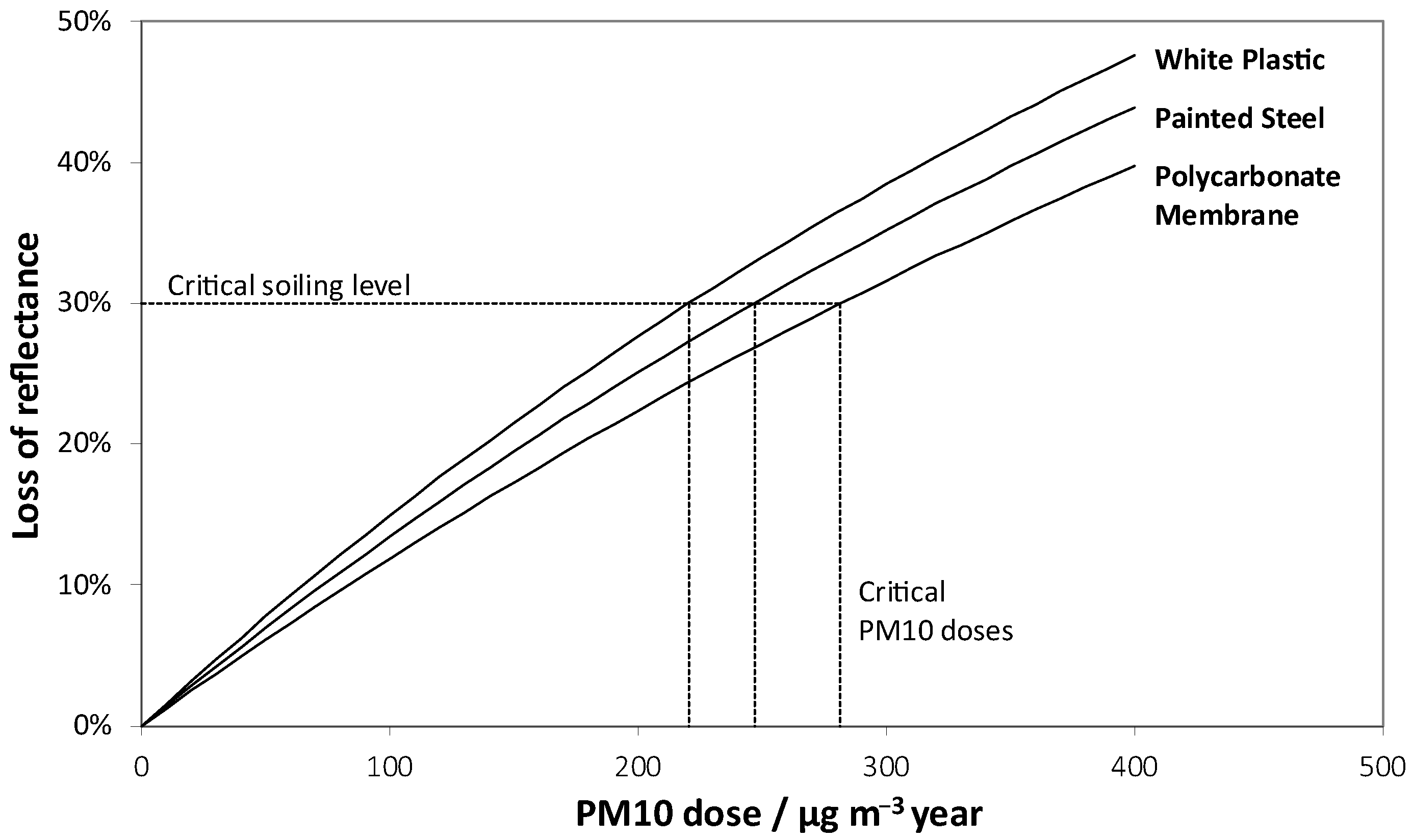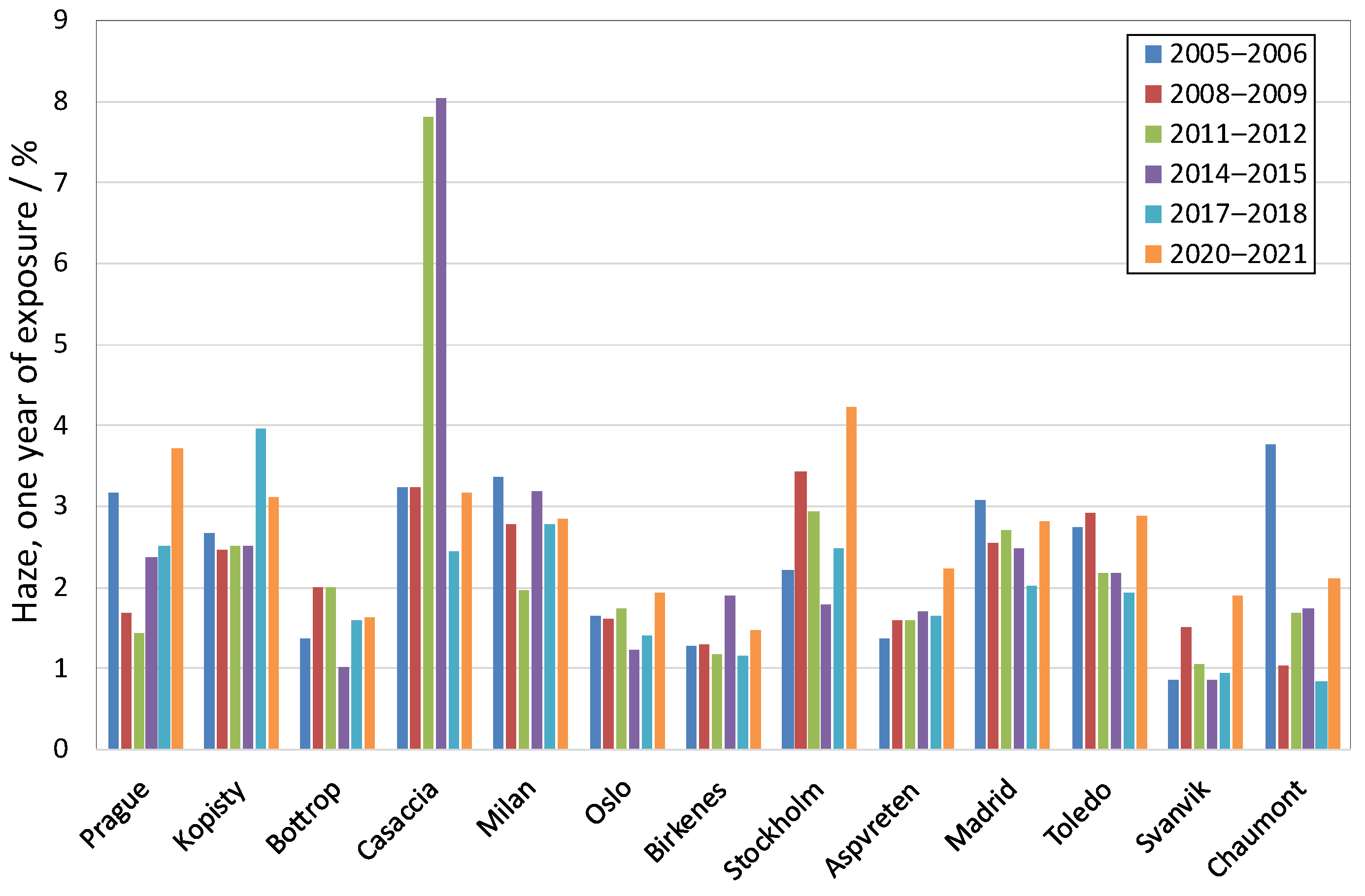1. Introduction
The International Co-operative Programme on Effects on Materials including Historic and Cultural Monuments (ICP Materials) was initiated in the 1980s by Vladimir Kucera and Christofer Leygraf and is still ongoing. With over a hundred publicly available reports [
1], scientific achievements in the field of atmospheric corrosion, and a time span of forty years, it is unique in the field of atmospheric exposure programs and its development tells a story of important policy developments, from acid rain to climate change and multi-pollutant effects. The purpose of this review article is to give an overview of the results from ICP Materials with special emphasis on those obtained after the turn of the century.
The most recent review article of this kind was published in 2012, when ICP Materials celebrated 25 years of research [
2]. This provided a complete overview of all exposures, materials, test sites, and measurements and showed clearly the dramatic decrease in corrosion in the 20th century in Europe due to decreasing levels of acidifying pollutants. It also included some trends in nitrogen pollutants, first results of soiling of modern glass due to particulate matter, and specific results for different types of cultural heritage, indicating the future directions of ICP Materials as it was seen at that time. Based on the findings of our previous review article and the observed decline in corrosion prior to the year 2000, the present article focuses on investigating corrosion trends from the year 2000 until the year 2020, for which data is available.
ICP Materials supports the Convention on Long-Range Transboundary Air Pollution [
3] by providing scientific input to the policy process and does this together with other ICP’s and task forces focusing on, for example, health, forest, water, and crop effects. An important milestone in this context was the 2012 amendment to the Protocol to Abate Acidification, Eutrophication and Ground-level Ozone that for the first time specifically mentioned effect on materials and cultural heritage and multipollutant effects including effect of particulate matter. This was the start of further emphasis on materials sensitive to soiling, and a realization that assessment of effects and corresponding costs of corrosion and soiling needed to be performed together.
Another shift in the focus of ICP Materials was to cultural heritage and to describe the results in terms of policy-relevant indicators. In 2010 it was decided to systematically include case studies of corrosion and soiling at United Nations Educational, Scientific and Cultural Organization (UNESCO) cultural heritage sites, and at this point many reports have been issued covering heritage from north to south and of many different categories. The case studies include corrosion and soiling aspects as well as calculation of associated costs. This is also reflected in the structure of this review article. It starts by describing the effects and trends in corrosion with emphasis on the 21st century, followed by a similar description of soiling, including recently developed functions for predicting soiling. It then discusses corrosion and soiling together and the effects on monuments located primarily at UNESCO cultural heritage sites. Finally, possible future directions of the program are discussed in relation to recent trends like globalization and digitalization.
2. Methodology
The ICP Materials programme has historically operated through a network of exposure sites mainly distributed across Europe, with one current site in the US. These sites represent different climate conditions and pollution levels, classified into urban, rural, and industrial, albeit these categories have been modified during the years due to changes in air pollution. Each site is equipped with racks that allow for the long-term exposure of metallic, stone, and glass materials, as well as the recording of environmental data via stations or through passive samplers in more remote areas. The sites follow standardized protocols to place and retrieve samples at the beginning and end of campaigns. This geographically varied selection of sites provides robust datasets that allow the development and validation of dose–response functions. Each site is named after the closest city or locality; however, the reported information is not intended to reflect the whole region. Active and inactive sites are shown in
Figure 1. The most recent published Technical Manual (Annex) contains a comprehensive list of active and inactive sites [
1]. Sites 1–39 were established for the first exposure in 1987, following the addition of sites 40–49 in 1997 for the multi-pollutant exposure. Sites 50–62 have been subsequently added over the years. Note that some sites have only been utilized since the turn of the century and have been discontinued from the network for different reasons; missing numbers correspond to not-launched stations.
The trend exposure campaigns are organized according to a set schedule, starting with the decision of the Task Force to initiate the new campaign and finalizing with public reports on environmental data and trends on corrosion and soiling. The Task Force decides which materials, test sites, environmental data, and exposure periods are to be included. Each test site (National Focus Point) is responsible for collecting their own environmental data and placing the samples at the settled date. Each subcentre is responsible for the preparation and distribution of materials to all test sites, as well as the subsequent evaluation of the exposed specimens once the campaign is over. The Environmental Centre (NILU, Norway) is responsible for collecting and compiling the environmental data at set intervals. Finally, the Main Research Centre is responsible for overall coordination and reporting the trends for corrosion and soiling.
Table 1 shows the list of mandatory and optional environmental parameters that have been measured by the network of sites during campaigns taking place after the year 2000.
Metallic materials are exposed in sheltered or unsheltered conditions from the environment, with the aim of determining long-term corrosion rates generally after 1, 2, 4, and up to 8 years of exposure. Limestone materials have been exposed in unsheltered conditions to estimate the recession rate, also referred to as “corrosion rate”. Glass and stone materials are exposed in sheltered conditions to determine haze and reflectance changes over the exposure period. Reflectance changes are taken as a relative measurement with respect to the reflectance of samples before the start of exposure.
Figure 2 shows an image of a typical test site, where different materials are exposed on a rack. Details about the methodologies employed for quantification of corrosion and reflectance are published on the ICP Materials website [
1].
The subcentre SVUOM (Czech Republic) is responsible for the preparation and evaluation of the trend material carbon steel (1.0036 according to EN 10027-2, C ≤ 0.2%, P > 0.07%, Cr > 0.07%). Since the turn of the century, data from unalloyed carbon steel samples exposed in unsheltered conditions is available for the years 2000–2001 (Report 56 [
1]), 2002–2003 (Report 56 [
1]), 2005–2006 (Report 53 [
1]), 2008–2009 (Report 67 [
1]), 2011–2012 (Report 72 [
1]), 2017–2018 (Report 85 [
1]), 2020–2021 (Report 92 [
1]), and 2021–2022 (Report 95 [
1]). Four-year exposures are also available for the years 2011–2014 (Report 78 [
1]) and 2017–2020 (Report 92 [
1]).
The trend material zinc has been evaluated in three different forms: the so-called traditional zinc (evaluated by SVUOM), blasted zinc which has had surface preparation (evaluated by EMPA, Switzerland), and titanium zinc (evaluated by EMPA). Parallel unsheltered exposures of traditional and blasted zinc were carried out in 2000–2001 (Reports 43 and 47 [
1]) and 2008–2009 (Report 62 [
1]), resulting in an empirical formula that allows for the comparison of corrosion rates between these two types of zinc.
One-year exposures for blasted zinc have been carried out in the years 2002–2003 [
4], 2005–2006 (Report 54 [
1]), 2011–2012 (Report 72 [
1]), 2014–2015 (Report 78 [
1]), and 2017–2018 (Report 85 [
1]). Titanium zinc (99.995% Zn) has been suggested as a potential substitute of blasted zinc as trend material, due to its commercial availability and relevance in infrastructure applications. One parallel one-year exposure (2020–2021) has been carried out comparing titanium zinc and blasted zinc (Report 92 [
1]), and another including traditional zinc is underway for the period 2024–2025.
Portland limestone has been exposed throughout the century in unsheltered conditions in 2002–2003 [
4], 2005–2006 (Report 55 [
1]), 2008–2009 (Report 66 [
1]), 2011–2012 (Report 72 [
1]), 2014–2015 (Report 78 [
1]), and 2021–2022 (Report 95 [
1]) to determine the surface recession, due to its importance as a building material. Four-year exposures have also been conducted during the years 2011–2014 (Report 78 [
1]) and 2017–2020 (Report 92 [
1]). The subcentre responsible for preparation and evaluation of limestone samples was BRE, UK, until the year 2022, taken over by LISA, France the same year.
Over the years, additional metallic materials have been incorporated into the trend exposure programme. However, the availability of data for these materials remains limited. Examples include aluminium, copper, bronze, stainless steel, and medieval glass. Reports on these materials can be accessed through our website, ICP Materials [
1].
3. Trends in Air Pollution for the 21st Century
Air pollution data for gaseous pollutants (SO
2, NO
2, O
3, HNO
3) is collected at each site of ICP Materials with O
3 and HNO
3 becoming mandatory from 2005 (Report 51 [
1]). Data of PM10 (airborne particulate matter with aerodynamic diameter up until 10 µm) have not been reported at all sites but it will become a mandatory parameter from the year 2025. Other parameters such as HCOOH and CH
3COOH have been collected in specific campaigns (Report 75 [
1]) but have not been repeated.
Anthropogenic sulphur dioxide emissions dropped significantly before the turn of the century, owing largely to policy which led to the increased usage of cleaner fuels and renewable sources, with CLTRAP playing a major role regarding this decline [
5]. Within the ICP Materials network sites, during the 21st century the reduction of SO
2 levels remains steady and significant for sites deemed “industrial”.
Figure 3 shows the annual average SO
2 concentrations at industrial, urban, and rural sites from the year 2000 to 2020. For industrial sites the levels have dropped below 10 µg m
−3, while for rural and urban sites below 5 µg m
−3.
NO
2 levels have not dropped as significantly as SO
2 levels in industrial and urban areas. Rural sites have maintained low levels below 5 µg m
−3 since the year 2000, while industrial and urban sites remain at approximately 20 µg m
−3 (see
Figure 4).
Another important pollutant that has been measured within the ICP Materials programme is tropospheric ozone. It is known that ozone has a complex and non-linear chemistry of formation and termination, which is highly dependent on interactions with other pollutants and weather parameters. Measured ozone levels within the programme have varied slightly since the year 2000 but have not decreased significantly (see
Figure 5). In agreement with the literature, rural sites exhibit higher ozone levels due to formation and termination mechanisms related to NO
X and VOCs availability, as well as meteorological conditions [
6].
HNO
3 has been measured by the network since 2002, the year in which PM10 was also included, however, as a non-mandatory parameter. The limited amount of data points, especially for PM10, does not allow a comparison between urban, industrial, and rural sites. Examining three individual sites,
Figure 6 shows that PM10 concentrations in Birkenes (rural) and Madrid (urban) do not exhibit significant changes since the beginning of the monitoring campaign. PM10 concentrations in Bottrop (industrial) have approximately halved over the monitoring period. For HNO
3 concentrations, Bottrop and Madrid are generally showing a downward trend while Birkenes has remained stable from the beginning of the measuring campaign at levels below 0.2 µg m
−3 (see
Figure 7).
4. Trends in Corrosion for the 21st Century
Since the beginning of the programme until the year 2000, the declining trend in acidifying air pollutants has been consistently followed by a decrease in corrosion rates for the trend materials unalloyed carbon steel, zinc, and limestone. This correlation highlights the effectiveness of air quality improvement measures to mitigate material degradation.
After the turn of the century, carbon steel still exhibits a declining trend in corrosion, albeit less pronounced, especially in urban and rural areas where the mass loss levels have stabilized on average at approximately 30 g m
−2 over the past three trend exposures (
Figure 8). Notably, between the years 2014 and 2017, a more substantial decrease in mass loss was observed, approximately 38%, which remained at similar levels through the subsequent exposures in 2020 and 2021.
Figure 9 illustrates the mass loss for carbon steel after one year of exposure at the Prague site (urban), alongside average values from other urban locations (excluding Prague), and the corresponding SO
2 concentrations in Prague recorded since the year 2000. The corrosion levels in Prague follow the urban site trend over the years, and the downward trend observed in SO
2 levels is aligned with this decrease in corrosion as well. However, certain deviations are evident, most notably in 2005, when elevated SO
2 levels did not correspond with increased corrosion rates. This discrepancy highlights the complexity of the multi-pollutant condition and suggests SO
2 alone cannot fully account for the corrosion behaviour. For example, a particularly dry year could result in low corrosion levels, despite relatively high SO
2 concentrations.
Another relevant urban site is Madrid, which deviates from the average of urban sites in the network even to a greater extent than Prague (
Figure 10). SO
2 levels in Madrid have been historically lower than Prague, with the corresponding lower corrosion rates for carbon steel. At rural sites such as Birkenes (
Figure 11), SO
2 concentrations have been consistently remained below 0.5 g m
−2 since the year 2000; however, carbon steel corrosion rates do not exhibit a clear or consistent downward trend. During the most recent trend exposure, the mass loss levels at this site were nearly three times higher than the average observed across other rural sites. These findings reinforce the notion that there is a need for considering other pollutants and environmental factors when assessing and interpreting results.
Figure 12 shows the yearly average mass loss of zinc (blasted panels) from the year 2000 in industrial, urban, and rural sites in one-year exposures. The corrosion trends for zinc exhibit a modest overall decline with no clear downward trajectory of carbon steel, with fluctuations spanning all over the century. Despite these fluctuations, the overall level of zinc corrosion is relatively low, on average below 15 g m
−2. Up to the year 2014, industrial sites were on average more severe in terms of corrosion, followed by rural and ending with urban sites. In 2017 the pattern changed to rural sites having on average higher mass loss than industrial, albeit similar at 8 g m
−2 versus 7 g m
−2, respectively, while urban sites reached average values of about 5 g m
−2.
Figure 13 shows the corrosion data for zinc from four-year exposures across 19 sites, revealing a downward trend comparing the periods 1997–2000 and 2011–2014. However, comparing the periods 2011–2014 and 2017–2020 does not reveal the same trend. Instead, the data seems to show a stabilization of the corrosion rate and in some cases a slight increase.
Figure 14 illustrates the mass loss of Portland limestone after four years of unsheltered exposure in 19 sites across the network, covering three periods: 1997–2000, 2011–2014, and 2017–2020. Limestone recession rates have shown a clear downward trend comparing the three exposure periods in the sites Milan (urban) and Bottrop (industrial), probably reflecting local improvements in air quality. In contrast, the rural sites Birkenes, Aspvreten, and Casaccia have exhibited increased recession rates. Other urban sites in the network (Prague, Stockholm, and Toledo) have not exhibited significant trends regarding limestone recession, but rather a stabilization of them over time.
The inherent complexity of atmospheric corrosion processes has been addressed by the ICP Materials programme. The programme has proposed new updated dose–response functions intending to reflect the influence of multiple pollutants and environmental parameters. The development of these updated functions was a culmination of exposures taking place during the years 1997–2001 and evaluation of HNO
3 and particulate matter concentrations for the related project MULTI-ASSESS (2002–2003) [
4,
7,
8]. The updated dose–response functions were published first by Kucera et al. [
9] and later adapted to one-year mass loss values in the Mapping Manual [
10] for carbon steel, zinc, cast bronze, and Portland limestone. Dose–response functions are intended to be revised if trends deviate significantly from the previous period to ensure their relevance and accuracy reflecting the effects of pollutants and environmental conditions. Zinc’s dose–response function has been recently subjected to evaluation by the Task Force (Report 97 [
1]), due to insufficient significance in correlation between observed corrosion rates and predicted values.
5. Trends in Soiling for the 21st Century
It is evident that if a heritage building degrades and loses its structural integrity, it is negative. On the other hand, it is expected that it shows signs of its heritage and age gracefully. Soiling is a visual effect; buildings get darker with time due to pollutants in the air, but it is only when the observer considers this change as negative that the building is “soiled” as opposed to just naturally aged. Soiling is measured as relative loss of reflectance. There are several approaches that can be used to assess the point at which soiling triggers unacceptable responses from the public [
11]. When ICP Materials revised the Mapping Manual in 2022, dose–response functions for soiling were included for the first time. It proposed a threshold of 30% loss of reflectance for non-transparent materials and levels above that are considered not tolerable. Dose–response functions for white painted steel, white plastic, and polycarbonate membrane [
12], as well as two different functions for modern glass [
13,
14], are included in the manual [
10]. The dose–response functions for white painted steel, white plastic, and polycarbonate membrane all have the same generic form:
where ΔR is the loss of reflectance, R
0 is the reflectance of an unsoiled surface, k is a constant depending on the material (white painted steel, white plastic, and polycarbonate membrane), C is the PM10 concentration, and t is the exposure time. For limestone, previous studies could not determine k due to the high variability of data. Since limestone is such an important material for cultural heritage, values in the same range have been used to perform calculations [
15]. The product Ct is also referred to as the PM10 dose. These functions are illustrated in
Figure 15 together with derivations of critical PM10 doses for the materials. For example, painted steel will have a critical PM10 dose of about 250 µg m
−3 year (
Figure 15). If the PM10 concentration is known, it can be used to calculate the time when soiling is not tolerable, while if a reasonable maintenance time for cleaning is determined, it can be used to calculate tolerable levels of PM10, as exemplified when discussing cultural heritage case studies below. Reviews of dose–response functions for soiling including aesthetic thresholds are available as ICP Materials reports in addition to the exposure data described in the following.
In ICP Materials, modern glass was added as a material for analysis of soiling trends in 2005 and has been exposed by hanging vertically in sheltered position at the test sites. Evaluation of haze, which is considered the most appropriate parameter for evaluating trend effects, as well as total deposition of particulate matter, was made by the subcentre in Paris (LISA). Haze is the ratio between the diffuse and direct transmitted light [
16]. Data sets after one year of exposure are available for the periods 2005–2006 (Report 66 [
1]), 2008–2009 (Report 62 [
1]), 2011–2012 (Report 72 [
1]), 2014–2015 (Report 78 [
1]), 2017–2018 (Report 85 [
1]), and 2020–2021 (Report 92 [
1]). The exposure that started in 2008 was made for longer exposure periods (2, 3, and 4 years) in addition to the one-year period, with available data sets in 2008–2010, 2008–2011, and 2008–2012 (Report 74 [
1]). One-year data sets for the first four exposure periods, 2005–2006, 2008–2009, 2011–2012 and 2014–2015, have also previously been published in open access [
17].
Limestone, marble, and coil-coated materials were added as materials for evaluating soiling effects in 2017. Limestone and marble were also exposed in sheltered position and evaluated by LISA while white and grey coil-coated materials were exposed on open position and evaluated by the subcentre HAMK in Finland. As for soiling of modern glass, results for these materials are available for 2017–2018 (Report 85 [
1]) and 2020–2021 (Report 92 [
1]). The most recent set of exposure of limestone and marble is planned for the periods 2020–2021, 2020–2022, 2020–2024, and 2020–2026, corresponding to 1, 2, 4, and 6 years of exposure.
The time series for soiling is therefore, compared to corrosion, still relatively short for all materials except modern glass where six points are available between 2005 and 2021, as illustrated in
Figure 16. During this period there is no obvious overall increase or decrease in soiling, i.e., no trend.
6. Combined Corrosion and Soiling Effects for Cultural Heritage
The effects of air pollution on cultural heritage have always been an essential part of the work performed by ICP Materials. It has become even more important with decreasing levels of pollution, since corrosion and soiling levels need to be lowered to protect materials used in cultural heritage compared to materials used in technical constructions, considering the longer life spans of monuments and the sometimes more delicate parts. This is even reflected in the terminology in the “Mapping Manual” where corrosion and soiling levels for technical constructions are considered acceptable or not acceptable while those for cultural heritage are noted as just “tolerable” [
10].
A milestone in the ICP Materials work on cultural heritage was the EU project “CULT-STRAT” that resulted in the book “The Effects of Air Pollution on Cultural Heritage”. The book can serve as an introduction to the subject and includes chapters describing specific discussions for cultural heritage on environment, corrosion, soiling, stock at risk, economic evaluation, risk assessment, and air quality policy. The purpose here is not to give this detailed overview of effects on cultural heritage but instead to review the development of ICP Materials and its work on cultural heritage with a focus on the period after the book was published in 2009 [
18].
The main work on cultural heritage has been to perform case studies for individual monuments, cities, and even for a whole country (Italy). The case studies have generally followed the same structure, with the first step including a general description including assessment of the quantities and condition of the most important materials (stock at risk). The second step has then been the calculation of corrosion and soiling for the area of the respective case, based on collected environmental data and dose–response functions. As a rule, it has not been possible to perform actual corrosion and soiling measurements at the monuments. Instead, separate comparisons have been made by using the same data and dose–response functions at other areas where measurements are performed and comparing those calculations with actual corrosion and soiling measurements performed at the sites. The third step has been a risk assessment, individually or combined for corrosion and soiling, followed in some cases by an economic evaluation of the damage. These steps are reviewed in the following using examples from the case studies.
6.1. Overview of Performed Case Studies
The first case studies were performed in 2008–2010 for the cities Madrid in Spain (Report 57 [
1]) and Milan and Rome in Italy (Report 60 [
1]) and included inventories for stock of materials at risk as well as maps with calculated corrosion of selected materials overlapped with the location of different types of monuments. It was later followed up by a study for the whole of Italy presented in a similar way (Report 63 [
1]).
The first set of case studies for individual monuments were performed from 2011 to 2015 (see
Figure 17) and were described in a series of reports including an overview of the individual monuments (Report 68 [
1]), stock of materials at risk (Report 70 [
1]), economic evaluation (Report 73 [
1]), and evaluation of local sources of pollution and their individual effects (Report 77 [
1]). The following five UNESCO sites were included:
Greece, Athens, Acropolis, The Parthenon;
France, Paris, The Facades in the City Centre;
Czech Republic, Prague, The National Library;
Germany, Berlin, The New Museum;
UK, Bath, Royal Crescent.
In 2015 it was first proposed by the ICP Materials Task Force and later adopted by the working group on effects (WGE) of the Convention on Long-Range Transboundary Air Pollution (CLRTAP) to launch a so called “Call for Data”. The Call asked parties to CLRTAP for new case studies and accompanying relevant information. Six parties responded to the call: Croatia, Germany, Italy, Norway, Sweden, and Switzerland. After a first screening of all possible UNESCO case studies in the respective countries (Report 80 [
1]), a second set of case studies were selected comprising 21 individual monuments and sites. These results were also described in a series of reports including an overview of the individual monuments, stock at risk and risk assessment (Report 83 [
1]), economic evaluation (Report 86 [
1]), and an analysis of the most important pollutants contributing to the costs for the individual monuments (Report 89 [
1]). A detailed evaluation of local sources of pollution and their individual effects was only performed for 3 of the 21 monuments (Report 93 [
1]). The 21 case studies were also used in a recent analysis of trends based on data from the past (2000, 2010, and 2020) (Report 98 [
1]), and a report is planned for 2025 to follow up on this study with an economic evaluation for the same years.
Figure 18 shows an overview of the location of 21 monuments.
6.2. Evaluation of Stock of Materials at Risk
Numerous methods exist on how to assess the stock at risk for buildings depending on the geographical scale of interest. The methods have been applied in several countries in Europe, the United States, Canada, and in countries not party to CLRTAP, for example China. An important step when generalizing data to larger regions (upscaling) is to identify typical buildings and associate those with amounts of different materials and their exposed areas to the environment, so called “identikits”. When assessing and upscaling stock at risk for cultural heritage there are two fundamental difficulties. First, cultural heritage is generally classified as such because of its uniqueness. Second, different countries apply different criteria when classifying cultural heritage, a similar building may in one country be classified as cultural heritage but in another not (Report 61 [
1]). Therefore, studies so far are focused on case studies for individual monuments, where it is possible to assess the materials directly.
An example of stock at risk data is shown in
Table 2. A total of 14 of the 21 monuments contain limestone, where the amount of relative limestone surface ranges from slightly more than 1% (Nidarosdomen, Norway) to 100% (the Tower of Pisa, Italy). Sandstone is also an abundant material, while for metallic materials, copper (mainly present as roof material) and bronze (mainly present as bells in belfies) are the most frequent (Report 83 [
1]).
6.3. Calculation of Corrosion and Soiling
Both corrosion and soiling levels can be calculated using dose–response functions for the respective materials. However, to assess which degradation requires the most attention, it is necessary to convert the absolute values of corrosion and soiling to a measure that is comparable. This is illustrated by example for limestone and the Royal Palace of Caserta (see
Figure 19) in
Table 3, where both the surface recession (“corrosion”) and the soiling level have been used to calculate a maintenance time based on reasonable criteria for maintenance. The Royal Palace of Caserta has a volume of more than 2 million m
3, which makes it the royal palace with the largest volume in the world (Report 93 [
1]). The improvement in air quality results in increased recommended maintenance intervals for both soiling and corrosion. The maintenance time is generally lower for soiling compared to corrosion, indicating that soiling nowadays would be the determining factor when deciding on a renovation project. This contrasts with the situation when ICP Materials started in the 1980s and when corrosion levels were much higher due to the much-elevated SO
2 levels, in the range of 20 µm to 80 µm, for the first four years of exposure only [
17]. This would correspond to a maintenance time for surface recession, i.e., the time to reach 100 µm, much lower than is given in
Table 3 for both corrosion and soiling.
6.4. Risk Assessment
Together with stock at risk data, the calculations presented in
Table 3 can be used to make a first initial analysis of potential risks for a particular monument. This is illustrated in
Table 2 which gives an overview of the potential risks for the 21 monuments. Continuing with the Royal Palace at Caserta as an example, the table shows that both limestone and glass are used to a significant extent and therefore corrosion and soiling of limestone as well as soiling of modern glass are potential risks. Further steps in the analysis, i.e., to assess if the potential risks are real risks, need to be taken at the local level involving those who are responsible for the monuments.
6.5. Economic Evaluation and Local Policy Strategies
The cost of air pollution on cultural heritage can in principle be divided into two categories: direct costs and indirect costs. Direct costs are costs for material and personnel required to restore the heritage to a desired condition. This could, for example, be cleaning, painting, or renovating. This cost can be calculated by the equation
where ΔK is the cost (per year) due to air pollution, k is the cost per surface area of material, A is the total surface area, t is the maintenance time, and t
0 is the maintenance time for a comparison scenario, often without the effect of air pollution. Taking the Royal Palace of Caserta as an example and for one scenario (Report 86 [
1]), the maintenance time (t) was calculated to 20.5 years and the maintenance time for the ideal scenario (t
0) to 114 years, which means that the cost attributed to air pollution in this case would be slightly more than 80% of the total cost for renovation. Depending on levels of air pollution and climatic conditions at different monuments, this value could be as low as 40% but typically not more than 80% for the investigated cases (Report 86 [
1]). The absolute costs due to pollution are more uncertain and depend more on the input data and the reference year. During the period between maintenance, the cultural heritage is in a less favourable condition, especially just before the maintenance is taking place. This condition can be translated into a lower value of the building, possibly resulting in fewer visitors. The costs associated with this are named indirect costs and are much more difficult to calculate. It has been shown that if a heritage owner uses rational decision making regarding when to initiate maintenance, it is favourable to do that in such a way that the direct and indirect costs are similar [
20]. Therefore, it is common to estimate the total cost (direct and indirect) as twice that of the direct costs.
Continuing with the Royal Palace at Caserta as an example, despite the need for restoration, structures collapsed in 2012. An extensive restoration project on external and internal facades amounted to 15 million EUR, in part co-financed by the European Regional Developing Fund (Report 93 [
1]). This illustrates that the decision making is not always rational and that the cost calculated by equation 2 cannot be used to predict the actual cost for a single monument. However, on a larger scale it gives an indication of the magnitude of the costs and probably underestimates the costs, since availability of funding rather than rational decision making determines the restoration time.
Detailed case studies investigating the effect of local policy strategies were performed for only 3 of the 21 monuments: the Saint Domnius, Split, Croatia, the Würzburg Residence, Bavaria, Germany, and the Royal Palace, Caserta, Italy. These were selected since they had substantial maintenance costs and represented different climatic, topographic, and emission-related characteristics. The data collected included sector contribution to emission inventories, main pollutants, and local air pollution data. Road transport was identified as an important source contributing to the poor air quality for the case studies (Report 93 [
1]). Several UNESCO monuments are in metropolitan areas, emphasising the need to focus on road transport to further reduce effects of air pollution on cultural heritage.
7. Summary and Discussion
ICP Materials was initiated in the 1980s when the effect of “acid rain” was the main concern for forests, lakes, and the fish population, but also for atmospheric corrosion and corrosion in soil. At that time several other ambitious programs were also started, for example the National Acid Precipitation Assessment Program (NAPAP) in the US [
21], ISO CORRAG [
22], and the Ibero-American Map of Atmospheric Corrosiveness (MICAT) [
23]. While these other programs were concluded as acid rain became less of a problem, ICP Materials is still ongoing. This is mainly due to the multi-effect framework of the Convention on Long-Range Transboundary Air Pollution, including effects on health and ecosystems together with its ability to transform as new environmental challenges have emerged. The Protocol to Abate Acidification, Eutrophication and Ground-level Ozone was signed in 1999 in Gothenburg, Sweden, and is also referred to as the multi-pollutant, multi-effect Protocol or simply the Gothenburg Protocol. At that time Acidification was still a major problem, but the focus was gradually shifting and in 2012 the Gothenburg Protocol was amended to specifically include the effect of particulate matter, mainly driven by health concerns in urban areas.
The shift in focus from acidification to nitrogen/ozone and then particulate matter is also manifested in the work of ICP Materials. The decreasing trend in corrosion was most evident up until the year 2000 but has been less dramatic since then (
Section 4), mainly related to the decrease of SO
2 but also other acidifying pollutants. Later, in the review paper “Effects of Air Pollution on Materials and Cultural Heritage: ICP Materials Celebrates 25 Years of Research” published in 2012 [
2], the effects and trends of nitrogen pollutants including nitric acid were particularly emphasised. Concentration of nitric acid and other nitrogen pollutants have continued to decrease (
Section 3) but the decrease in corrosion directly related to decrease in nitrogen pollution is now less evident. Instead, particulate matter has the greatest attention and, while it contributes to corrosion of materials, it has a larger impact on soiling of materials, an effect that has not decreased at all since the first “soiling material” was introduced in 2005 (
Section 5). When reviewing the trend in corrosion for the period 1987–2014 [
17], previous conclusions from 1987–2009 [
2] were confirmed, i.e., that when evaluating one-year data, it is only corrosion of carbon steel since that has decreased since the turn of the century. However, when evaluating four-year data [
17], there was also a decreasing trend in corrosion for zinc when comparing the periods 1997–2000 and 2011–2014. When comparing corrosion of zinc for the periods 2011–2014 and 2017–2020, no obvious decreasing trend is observed. Four-year data is obviously more sensitive than one-year data for detecting trends in corrosion. Even so, for limestone there is no decreasing trend in surface recession after the turn of the century when comparing the four-year exposure periods 1997–2000, 2011–2014, and 2017–2020.
The case studies performed on the UNESCO sites are a good illustration that combined risk assessments including both corrosion and soiling effects are necessary. Depending on the environmental situation, either corrosion or soiling can be the determining factor when deciding if maintenance should be performed. In the 21st century soiling is the determining factor in most cases, based on rational decision making. However, as exemplified (
Section 6), more tangible events such as the loss of structural integrity might tip the opinion to release funds for renovation, showing that assessment of corrosion is still relevant.
The main purpose of ICP Materials is to provide scientific and policy-relevant information that together with the other ICPs can help develop protocols for the Convention on Long-Range Transboundary Air Pollution, and to evaluate the effectiveness of such protocols to facilitate the reduction of effects, now and in the future. Therefore, data needs to be collected in real field conditions. There are some natural limitations with using field data; the experiments cannot be controlled and there is correlation between different environmental parameters that sometimes make the conclusions less certain in a scientific context. Furthermore, due to lack of funding and practical constraints, there are also gaps in the data where equipment or samples have been broken because of extreme environmental conditions. Nevertheless, numerous scientific publications have also resulted from the work [
24] and some of them with significant contributions to the understanding of atmospheric corrosion. This includes most notably the work of Leygraf et al., for example but not limited to the development of corrosion products under real field conditions [
25] as well as comparison on field exposure data with model experiments in the laboratory [
26]. Furthermore, results from the programme have been used towards work related to the protection of industrial infrastructure [
27].
ICP Materials has now released almost one hundred reports and all are publicly available [
1]. Furthermore, recent publications [
17] also include the data in an easily accessible form, making it possible for different stakeholders (policy makers, scientists, those involved in standardisation work, and the general public) to make their own analysis of the exposure data. This open data policy will continue to be implemented in further publications from ICP Materials.
9. Future Perspectives
To continue to be relevant, ICP Materials must be able to transform and assess new environmental challenges as they emerge and be able to do this in coordination with other ICPs while following the long-term strategy for the Convention on Long-range Transboundary Air Pollution for 2020−2030 and beyond [
3]. Highlighted pollutants in the strategy are ozone, particulate matter and its precursors, nitrogen, and sulphur, as well as persistent organic pollutants and heavy metals. Ozone could potentially have an impact on polymer-based materials together with other environmental parameters, but an evaluation of decay of polymeric samples (polyethylene and polyamide) exposed in the ICP Materials network revealed no effect of ozone (Report 28 [
1]). However, ozone levels show no decreasing trend and new exposures of polymeric materials are possible if a suitable material and subcentre can be identified. Otherwise, the pollutant highest on the agenda is particulate matter, which can affect both corrosion and soiling of materials. This will be the focus of ICP Materials for the coming years together with continued assessment of sulphur pollutants and to what extent they remain important for corrosion.
Another important strategic priority for the Convention is to improve the scientific and technical basis for the work [
3]. The effects-based monitoring using the network of test sites should be expanded, for example, by adding new sites and materials. Weathering steel was recently exposed for longer periods and for comparison with carbon steel corrosion. Forthcoming results of this material will make it possible to draw conclusions regarding the long-term trends. The most recent addition is Zn-Al-Mg coatings with withdrawal after one year of exposure at the end of 2025. Another possible extension is to use corrosion sensors at a larger portion of the test sites, thus enabling the systematic collection of time-resolved data [
28,
29]. This would be especially useful if combined with other data sources. An example of this approach is the use of remote sensing instruments aboard environmental satellites, which provide data of specific pollutants and environmental parameters that can be used to quantify corrosion and soiling via appropriate dose–response functions. Members of the Task Force have in the recent years deployed this new way of using satellite sensed data with dose-response functions [
30,
31,
32,
33].
Looking into the future of ICP Materials, there are clear trends within the corrosion and soiling community, namely big data, on-line sensing, artificial intelligence, and their combined use as prediction tools. The prediction of atmospheric corrosion of metallic materials has been a topic of study for many decades. The long-term nature of the necessary exposures to determine corrosion rates makes this type of prediction very attractive due to potentially substantial time and cost savings. Environmental data used as input, along with other parameters such as alloy composition, historical corrosion data, or corrosion sensor data, could be used in combination to train artificial intelligence-based predictive algorithms.
Finally, the Convention strategy [
3] specifically points out the importance of continuing to make the monitoring data gathered by ICP Materials, as well as the other ICPs, more easily available so that, even more than today, it can be a resource to different stakeholders in air quality including policy makers, scientists, those involved in standardisation, and the general public.


